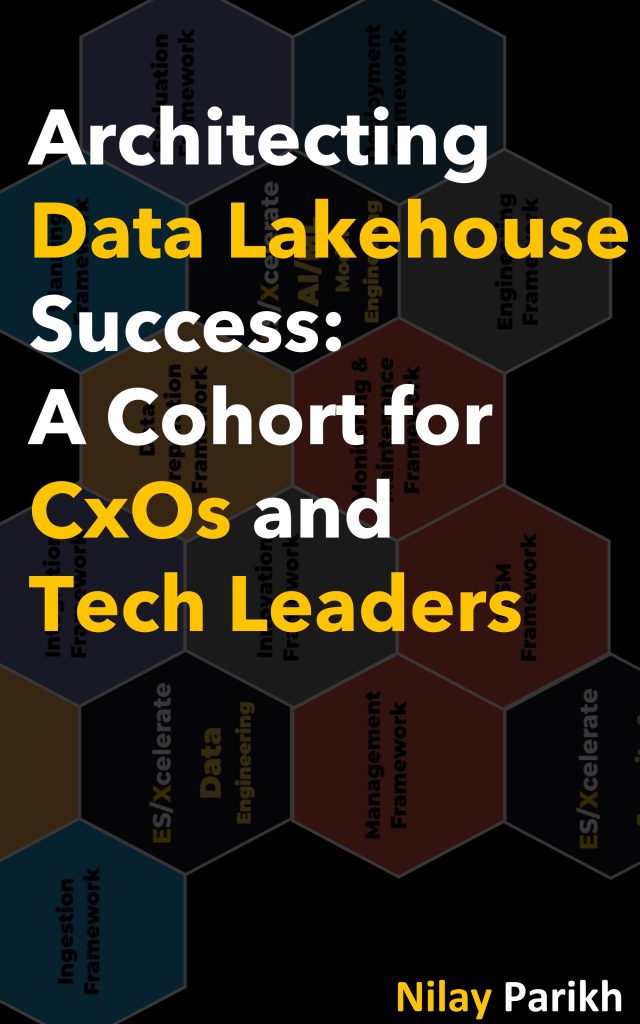
In “Architecting Data Lakehouse Success: A Cohort for CxOs and Tech Leaders,” we embark on an insightful journey through the evolving landscape of data engineering and architecture. This book is a comprehensive exploration, spanning the history, anatomy, and practical application of data lakehouses. It’s designed for technical leaders, architects, and C-suite executives who aim to merge strategic business vision with technical architectural prowess.
Chapter’s Summary
The chapter provides comprehensive guidance on best practices for deploying a data lakehouse across areas like phased rollouts, integrating data pipelines, facilitating user adoption, and enabling reliability through CI/CD pipelines.
It recommends a methodical, step-by-step approach from proof-of-concept to full production rollout. Strategies like identifying high-priority data sources, implementing automated ingestion workflows, managing change through communication plans, incentivizing usage, and leveraging infrastructure-as-code for consistency and automation can help organizations transition smoothly. Following this prescriptive advice will allow data architects to mitigate risks, accelerate value delivery, and build a versatile lakehouse architecture that meets their specific business needs.
Architectural Principles for Solution & Technical Architects and Enterprise Architects
| Principle | Description | Exceptions |
|---|---|---|
| Modular Design | Design applications with modular components for better scalability and maintainability. | Legacy systems not conducive to modularization. |
| User-Centric Design | Focus on user needs with intuitive interfaces and functionalities. | Back-end systems with minimal user interaction. |
| Continuous Integration/Continuous Deployment (CI/CD) | Ensure continuous and automated integration and deployment of application updates. | Systems where manual deployment is necessary due to security or regulatory reasons. |
| Data Integrity | Maintain accuracy and consistency of data throughout its lifecycle. | Scenarios requiring eventual consistency due to real-time processing. |
| Data Privacy | Protect sensitive data through encryption and access controls. | Public datasets not containing sensitive information. |
| Data Democratization | Make data accessible and understandable to non-technical stakeholders for informed decision-making. | Restricted or sensitive data requiring limited access. |
| Automation | Automate operational processes to improve efficiency and reduce error. | Critical tasks requiring direct human oversight. |
| Continuous Monitoring | Monitor systems continuously to proactively address performance and security issues. | Non-critical systems where periodic monitoring is sufficient. |
| Elastic Scalability | Design systems to scale resources up or down based on demand. | Fixed-capacity systems where scalability is not required or possible. |
| Least Privilege | Grant minimum necessary access for users and systems to perform a function. | Situations requiring temporary elevated privileges. |
| Defense in Depth | Implement multiple layers of security controls. | Small-scale or internal applications with limited exposure. |
| Zero Trust Security | Assume no implicit trust and verify every access request, irrespective of location. | Environments where zero trust implementation is not feasible. |
| Infrastructure as Code (IaC) | Manage and provision infrastructure through code for consistency and repeatability. | Scenarios where manual configuration is mandated. |
| Cloud-Native Design | Design solutions optimized for cloud environments, leveraging cloud-specific capabilities. | On-premises or legacy systems not supporting cloud-native features. |
| Strategic Alignment | Align IT initiatives with business goals and strategies. | Projects with independent or experimental objectives. |
| Compliance and Regulatory Adherence | Adhere to relevant laws, regulations, and industry standards. | Areas with no specific compliance requirements. |
| Sustainability in Design | Incorporate eco-friendly and sustainable practices in technology design and deployment. | Scenarios where green technologies are not yet feasible. |
| Cross-Functional Collaboration | Promote collaboration across different departments for comprehensive solutions. | Highly specialized tasks requiring focused expertise. |
| Resilience and Disaster Recovery | Design systems to withstand failures and recover quickly from disasters. | Non-critical systems where high availability is not a primary concern. |
| Innovation and Experimentation | Encourage innovation and experimentation to foster new ideas and solutions. | Strictly regulated environments where experimentation is limited. |
Structured approaches for Product Managers and Business Analysts
The deployment of a lakehouse data platform and encompasses aspects like phased rollout, user onboarding, CI/CD pipelines, data source integration, and change management, here are proposed epics and their respective features for the roles of a Product Manager and a Business Analyst.
Epic: Phased Rollout of Data Lakehouse
| Feature Title | Goal |
|---|---|
| Proof of Concept (PoC) Development | To validate the feasibility of the lakehouse architecture for specific business needs and technical requirements. |
| Pilot Implementation Planning | To evaluate the lakehouse in a quasi-real-world environment with expanded data sources and use cases. |
| Staged Deployment Strategy | To gradually deploy the lakehouse across departments, mitigating risks and allowing for feedback-driven adjustments. |
| Full-Scale Production Deployment | To achieve organization-wide deployment of the lakehouse, fully integrated into the business’s data strategy. |
Epic: User Onboarding and Adoption
| Feature Title | Goal |
|---|---|
| User Training and Support Programs | To facilitate smooth transition to the new system by providing comprehensive training and support. |
| Feedback Mechanisms and Continuous Improvement | To gather user feedback for ongoing improvement of the lakehouse platform. |
| Adoption Tracking and Incentivization | To monitor platform usage and incentivize desired user behaviors. |
| Role-Based Access and Customization | To tailor the lakehouse experience to different user roles and needs. |
Epic: CI/CD and Infrastructure Automation
| Feature Title | Goal |
|---|---|
| Implementing CI/CD Pipelines | To automate testing and deployment processes for rapid and reliable updates to the lakehouse. |
| Infrastructure as Code (IaC) Integration | To streamline provisioning and management of lakehouse infrastructure using code. |
| Continuous Monitoring and Logging | To ensure the health and performance of the lakehouse through proactive monitoring. |
Epic: Data Source Integration and Pipeline Efficiency
| Feature Title | Goal |
|---|---|
| Data Source Auditing and Prioritization | To identify and categorize data sources based on their value and relevance to the organization. |
| Robust Data Ingestion Pipelines | To establish efficient and reliable data ingestion methods tailored to the lakehouse. |
| Ensuring Data Quality and Governance | To maintain high standards of data quality and adhere to governance practices across all pipelines. |
Epic: Change Management and Organizational Alignment
| Feature Title | Goal |
|---|---|
| Developing a Comprehensive Communication Plan | To keep all stakeholders informed and aligned with the lakehouse deployment process. |
| Executive Engagement and Alignment | To secure and maintain leadership support for the strategic direction of the lakehouse initiative. |
| Change Impact Analysis and Management | To understand and manage the impacts of the lakehouse deployment on existing workflows and processes. |
Tables represent structured approaches for Product Managers and Business Analysts to develop and track significant components of the lakehouse deployment project, aligning with the overarching goals of each epic.
Available at Amazon
- US: https://www.amazon.com/dp/B0CR71D58S
- UK: https://www.amazon.co.uk/dp/B0CR71D58S
- IN: https://www.amazon.in/dp/B0CR71D58S
- DE: https://www.amazon.de/dp/B0CR71D58S
- FR: https://www.amazon.fr/dp/B0CR71D58S
- ES: https://www.amazon.es/dp/B0CR71D58S
- IT: https://www.amazon.it/dp/B0CR71D58S
- NL: https://www.amazon.nl/dp/B0CR71D58S
- JP: https://www.amazon.co.jp/dp/B0CR71D58S
- BR: https://www.amazon.com.br/dp/B0CR71D58S
- CA: https://www.amazon.ca/dp/B0CR71D58S
- MX: https://www.amazon.com.mx/dp/B0CR71D58S
- AU: https://www.amazon.com.au/dp/B0CR71D58S
Disclaimer
The views expressed on this site are personal opinions only and have no affiliation. See full disclaimer, terms & conditions, and privacy policy. No obligations assumed.
